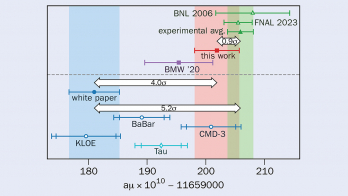by Gerardus ‘t Hooft (ed), World Scientific. Hardback ISBN 9812389342, £51 ($84). Paperback ISBN 9812560076, £21 ($34).
Anniversary volumes usually mark a significant birthday of an individual, or perhaps an institution. But this fascinating compilation celebrates the golden jubilee of a theory – namely, the type of non-Abelian quantum gauge field theory first published by Chen Ning Yang and Robert L Mills in 1954, and now established as a central concept in the Standard Model of particle physics. It was a brilliant idea (by the editor, Gerardus ‘t Hooft, I assume) to signal the 50th birthday of Yang-Mills theory by gathering together a wide range of articles by leading experts on many aspects of the subject. The result is a most handsome tribute of both historical and current interest, and a substantial addition to the existing literature.

There are 19 contributions, only two of which have been published elsewhere. They are grouped into 16 sections (“Quantizing Gauge Fields”, “Ghosts for Physicists”, “Renormalization” and so on), each accompanied by brief but illuminating comments from the editor. The style of the contributions ranges from an equation-free essay by Frank Wilczek, to a paper by Raymond Stora on gauge-fixing and Koszul complexes. Somewhere in between lie, for example, François Englert’s review of “Breaking the Symmetry”, and Stephen Adler’s exemplary account of “Anomalies to All Orders”.
One recurrent theme is how unfashionable quantum field theory was in the 1950s and 1960s. As ‘t Hooft puts it: “In 1954, most of those investigators who did still adhere to quantum field theory were either stubborn, or ignorant, or both. In 1967 Faddeev and Popov not only had difficulties getting their work published in Western journals; they found it equally difficult to get their work published in the USSR, because of Landau’s ban on quantized field theories in the leading Soviet journals.” One of the most interesting papers in the book is the 1972 English translation of their 1967 “Kiev Report”, produced via an initiative of Martinus Veltman and Benjamin Lee. It is more detailed than their famous 1967 paper in Physics Letters, and includes a discussion of the gravitational field.
Alvaro De Rújula inimitably brings to life the strong interactions between theorists and experimentalists in the heady days of 1973-1978. He includes a candid snap of Howard Georgi and Sheldon Glashow, circa 1975, which made me wish there were more such shots of the leading players from that era. De Rújula’s is the only contribution to address the experimental situation, despite the editor’s admission that the lasting impact of Yang-Mills theory depended on “numerous meticulous experimental tests and searches”. But, after all, this is a volume celebrating the birthday of a theory.
Many contributors look to the future, as well as the past. These include Alexander Polyakov on “Confinement and Liberation”, Peter Hasenfratz on “Chiral Symmetry and the Lattice”, and Edward Witten on “Gauge/String Duality for Weak Coupling”.
I have only had space enough to (I hope) whet the reader’s appetite. This unusual and elegant festschrift is a treat for theorists – and, as a bonus, you get a full-colour representation on the cover of a 17-instanton solution of the Yang-Mills field equations (designed by the editor).







